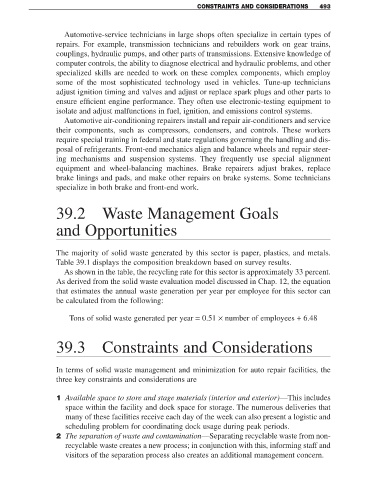Page 515 - Solid Waste Analysis and Minimization a Systems Approach
P. 515
CONSTRAINTS AND CONSIDERATIONS 493
Automotive-service technicians in large shops often specialize in certain types of
repairs. For example, transmission technicians and rebuilders work on gear trains,
couplings, hydraulic pumps, and other parts of transmissions. Extensive knowledge of
computer controls, the ability to diagnose electrical and hydraulic problems, and other
specialized skills are needed to work on these complex components, which employ
some of the most sophisticated technology used in vehicles. Tune-up technicians
adjust ignition timing and valves and adjust or replace spark plugs and other parts to
ensure efficient engine performance. They often use electronic-testing equipment to
isolate and adjust malfunctions in fuel, ignition, and emissions control systems.
Automotive air-conditioning repairers install and repair air-conditioners and service
their components, such as compressors, condensers, and controls. These workers
require special training in federal and state regulations governing the handling and dis-
posal of refrigerants. Front-end mechanics align and balance wheels and repair steer-
ing mechanisms and suspension systems. They frequently use special alignment
equipment and wheel-balancing machines. Brake repairers adjust brakes, replace
brake linings and pads, and make other repairs on brake systems. Some technicians
specialize in both brake and front-end work.
39.2 Waste Management Goals
and Opportunities
The majority of solid waste generated by this sector is paper, plastics, and metals.
Table 39.1 displays the composition breakdown based on survey results.
As shown in the table, the recycling rate for this sector is approximately 33 percent.
As derived from the solid waste evaluation model discussed in Chap. 12, the equation
that estimates the annual waste generation per year per employee for this sector can
be calculated from the following:
Tons of solid waste generated per year = 0.51 × number of employees + 6.48
39.3 Constraints and Considerations
In terms of solid waste management and minimization for auto repair facilities, the
three key constraints and considerations are
1 Available space to store and stage materials (interior and exterior)—This includes
space within the facility and dock space for storage. The numerous deliveries that
many of these facilities receive each day of the week can also present a logistic and
scheduling problem for coordinating dock usage during peak periods.
2 The separation of waste and contamination—Separating recyclable waste from non-
recyclable waste creates a new process; in conjunction with this, informing staff and
visitors of the separation process also creates an additional management concern.

